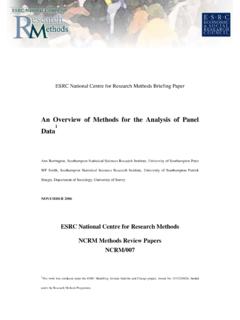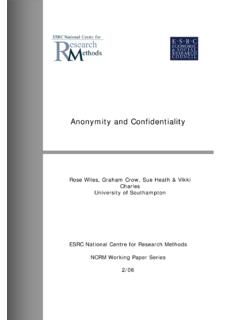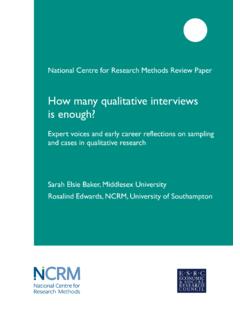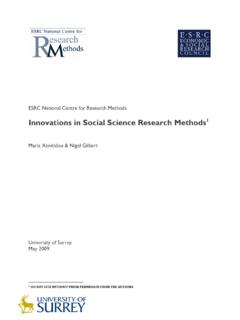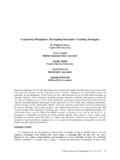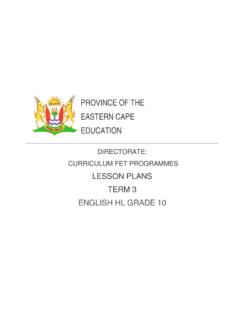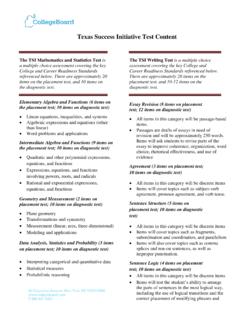Transcription of Six strategies for mixing methods and linking data in ...
1 Six strategies for mixing methods and linking data in social science research ESRC National Centre for Research methods NCRM Working Paper Series 4/06 Jennifer Mason University of Manchester Real Life methods A node of the National Centre for Research methods at the Universities of Manchester and Leeds Working Paper Six strategies for mixing methods and linking data in social science research Jennifer Mason University of Manchester July 2006 Real Life methods , Sociology, University of Manchester, Manchester M13 9PL +44 (0) 161 275 0265 Real Life methods Working Papers: Six strategies for mixing methods and linking data July 2006 2 Author contact details Professor Jennifer Mason Real Life methods (a node of the ESRC National Centre for Research methods ) Sociology Roscoe Building School of Social Sciences University of Manchester Manchester M13 9PL Real Life methods Working Papers: Six strategies for mixing methods and linking data July 2006 3 Introduction This paper is written as a practical and accessible guide to some key issues in mixed methods research.
2 It explores six broad strategies that can underpin the mixing of methods and linking of different forms of data, be they qualitative, quantitative, or spanning this divide. It does this in a context where mixing methods has come to be seen as a good thing, and where research funders are increasingly thought to look favourably upon research proposals involving more than one method for generating and analysing data. Yet mixing methods for no good reason other than the sake of it can produce disjointed and unfocussed research, and can severely test the capabilities of researchers. Researchers engaging in mixed methods research need to have a clear sense of the logic and purpose of their approach and of what they are trying to achieve, because this ultimately must underpin their practical strategy not only for choosing and deploying a particular mix of methods , but crucially also for linking their data analytically.
3 The paper outlines challenges and opportunities that each of the six strategies brings for mixed methods practice and analysis, giving each a verdict. 1. mixing methods for a close-up illustration of a bigger picture, or for background Probably the most commonly used logic in mixing methods is where researchers wish to add some breadth or depth to their analysis. This is often done by researchers who have primarily either a quantitative or qualitative orientation, but also a sense that their methods and data are partial in some respect. For those with a quantitative orientation, the big picture gained through quantitative means may be rigorous, and based on representative or statistical forms of sampling and analysis, yet also feel superficial or lacking in real life resonance. From that perspective, the use of selected qualitative approaches for example in the form of in-depth case studies can be illustrative and evocative, and provides a more close-up view.
4 Conversely, for a researcher with a primarily qualitative orientation, which focuses on social processes in rich and proximate detail, the inclusion of some background quantitative material, perhaps in the form of local or national demographic data, can help in making the research part of a bigger set of observations. Real Life methods Working Papers: Six strategies for mixing methods and linking data July 2006 4 = = = = A rhetorical logicA rhetorical logicA rhetorical logicA rhetorical logic The logic of this kind of approach is inherently rhetorical that is to say, from whatever their starting point, the researcher uses the other form of data to embellish their analysis, but it is not really considered to be a necessary part of the argument. Essentially, the additional data is just that a supplement and the explanatory logic itself is either qualitative or quantitative.
5 Challenges and opportunitiesChallenges and opportunitiesChallenges and opportunitiesChallenges and opportunities The ambitions of this kind of approach are, methodologically speaking, extremely modest. There is no real attempt at multi-method explanation or dialogue, and the research design and strategy is governed by an either/or, quant-or-quali , methodological logic. For that reason, this kind of approach raises few challenges. It is not difficult for a skilled quantitative researcher to work out for themselves how to include a few qualitative examples, or for a qualitative researcher to include a bit of quantitative background taken from published sources for example. Neither has to get to grips with how exactly one might sample, or generate data systematically and creatively, from a perspective other than the one with which they are familiar. Neither has to work out what a mixed methods explanation or interpretation might look like.
6 But of course the opportunities are just as limited as are the risks, since this approach does not involve considering what kinds of questions could be pursued were the researcher to use each form of method to its best advantage, rather than as embellishment. This kind of approach also has the tendency to polarise quantitative versus qualitative methods , without introducing the researcher to the exciting complexities of differences within those broad categories. VERDICT- mixing methods WITH A rhetorical LOGIC: EASY TO DO, LOW RISK, BUT DOESN T TAKE YOU VERY FAR 2. mixing methods to ask and answer differently conceived or separate questions Sometimes researchers will feel that there are different sets of research questions which, although broadly related to the same overall topic, do not have a particular connection analytically speaking.
7 So, for example, a study of Real Life methods Working Papers: Six strategies for mixing methods and linking data July 2006 5 human-animal interactions might look at farming, the meat industry, hunting, zoo cultures, family pets, the role of animals in literature and the media and so on, but might not want to make any particular argument about whether and how these different domains are connected. Studies like this can be constructed as multi-part projects, often although not necessarily conducted by teams where different members have responsibility for the different parts. Here, different approaches and methodologies are necessarily present overall, but are by design not drawn into any form of integrative whole or overall argument. = A parallel logic= A parallel logic= A parallel logic= A parallel logic This kind of approach is governed by a parallel logic. It is different from the rhetorical logic identified above, because any one approach is not necessarily subsumed within the broad strategy of another.
8 Instead, each part of the study, or each mini-study, has its own logic of design, data generation, analysis and explanation, and these run in parallel. Of course these mini-studies need not be simply mono- methods ones, but this approach overall is essentially based on the idea of co-presence of multiple methods , rather than their integration. Challenges aChallenges aChallenges aChallenges and nd nd nd opportunitiesopportunitiesopportunitieso pportunities Once again, the challenges of this kind of approach (for mixed methods working at least) are few, because although multiple methods may be used to their best advantage, the question of how one might mix them or link data and analysis is ultimately ducked. The opportunities extend a little further than with the rhetorical logic outlined above though, both because there is no necessary squashing of different approaches into one dominant explanatory quant-or-quali frame (which will not fit all), and because if each mini-study is conducted well in its own terms, there may be considerable opportunities for secondary analysis that cross-cuts all of them at a later stage.
9 At that point, one can imagine some creative opportunities for linking data and explanation. In a multi-part or multi-question study of this kind, there is also some potential for the sparking of ideas across methodological boundaries and across the mini-projects, if the team members are able to and prepared to work at this. VERDICT - mixing methods WITH A PARALLEL LOGIC: FAIRLY EASY TO DO, MEDIUM RISK, BUT LIMITED BENEFITS, ALTHOUGH SOME INTERESTING POTENTIAL FOR EXPLOITING THE MULTIPLE methods USED, ESPECIALLY AT A LATER STAGE Real Life methods Working Papers: Six strategies for mixing methods and linking data July 2006 6 3. mixing methods to ask questions about connecting parts, segments or layers of a social whole Some studies are designed with several or multiple components as with the previous example, but also with a clear sense that these deal with integrated parts of a whole.
10 In this approach, different methods may be deployed because each is felt to be the best suited to its own specific part of the problem being researched, and because in combination they give a better sense of the whole because they can address a meaningful group of questions, eg the four key pieces in the jigsaw or the fiver layers of the wedding cake. To use an example, if a project was concerned with how and under what conditions children learn successfully , one might use, in strategic combination: a secondary analysis of national or local quantitative data on educational outcomes for children against different demographic and socio-economic criteria statistical modelling of outcome and contextual data to explore links between observed outcomes and a range of contextual criteria analysis of Local Education Authority and school documentary data to trace philosophies, policies, practices school based cultural ethnographies at specially selected schools interviews with key informants in and outside school outside-school (eg home, social milieux) based qualitative interviews, or home ethnographies children s video diaries, weblogs, and communication practices There is, of course, a huge range of possibilities that one could line up in pursuit of this (rather controversial)
